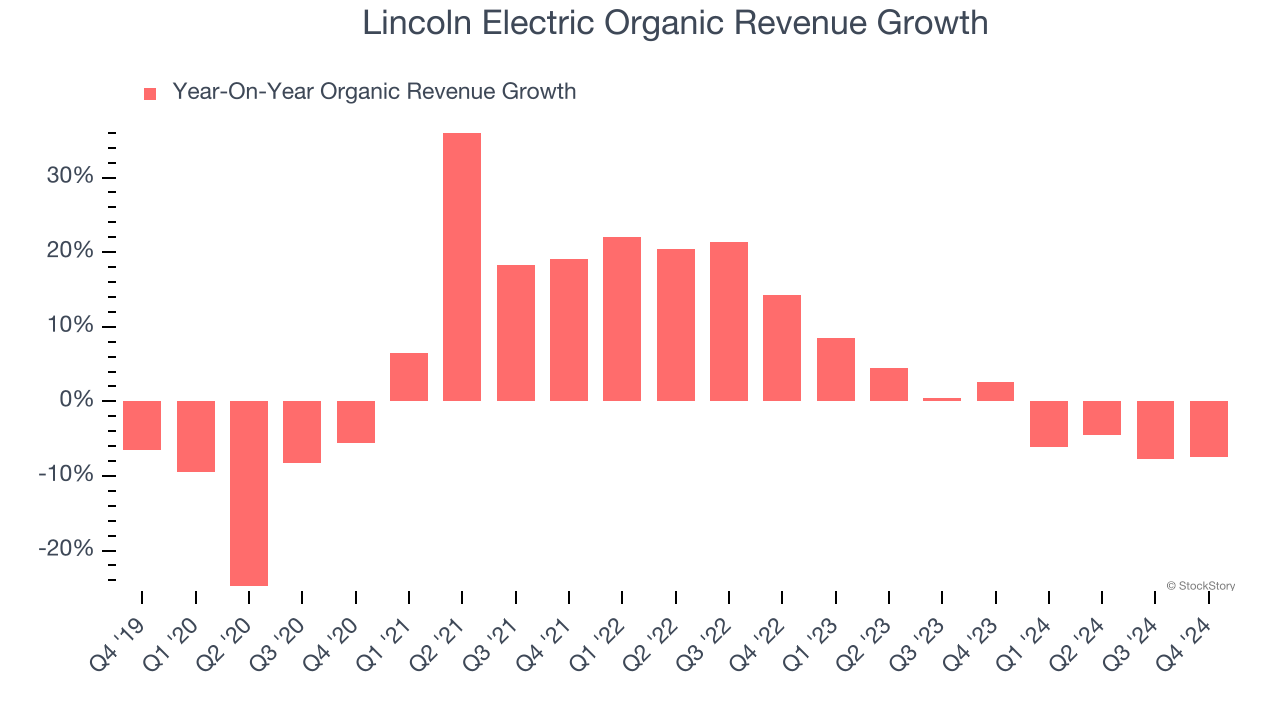
Lincoln Electric has followed the market’s trajectory closely. The stock is down 5.5% to $183.04 per share over the past six months while the S&P 500 has lost 6.9%. This might have investors contemplating their next move.
Is there a buying opportunity in Lincoln Electric, or does it present a risk to your portfolio? Check out our in-depth research report to see what our analysts have to say, it’s free.
Even with the cheaper entry price, we're sitting this one out for now. Here are three reasons why we avoid LECO and a stock we'd rather own.
Why Is Lincoln Electric Not Exciting?
Headquartered in Ohio, Lincoln Electric (NASDAQ:LECO) manufactures and sells welding equipment for various industries.
1. Core Business Falling Behind as Demand Declines
We can better understand Professional Tools and Equipment companies by analyzing their organic revenue. This metric gives visibility into Lincoln Electric’s core business because it excludes one-time events such as mergers, acquisitions, and divestitures along with foreign currency fluctuations - non-fundamental factors that can manipulate the income statement.
Over the last two years, Lincoln Electric’s organic revenue averaged 1.2% year-on-year declines. This performance was underwhelming and implies it may need to improve its products, pricing, or go-to-market strategy. It also suggests Lincoln Electric might have to lean into acquisitions to grow, which isn’t ideal because M&A can be expensive and risky (integrations often disrupt focus). 
2. Projected Revenue Growth Shows Limited Upside
Forecasted revenues by Wall Street analysts signal a company’s potential. Predictions may not always be accurate, but accelerating growth typically boosts valuation multiples and stock prices while slowing growth does the opposite.
Over the next 12 months, sell-side analysts expect Lincoln Electric’s revenue to stall, a slight deceleration versus its 3.2% annualized growth for the past two years. This projection doesn't excite us and indicates its products and services will see some demand headwinds.
3. Recent EPS Growth Below Our Standards
While long-term earnings trends give us the big picture, we also track EPS over a shorter period because it can provide insight into an emerging theme or development for the business.
Lincoln Electric’s EPS grew at an unimpressive 6% compounded annual growth rate over the last two years. On the bright side, this performance was higher than its 3.2% annualized revenue growth and tells us the company became more profitable on a per-share basis as it expanded.

Final Judgment
Lincoln Electric isn’t a terrible business, but it doesn’t pass our bar. After the recent drawdown, the stock trades at 19.4× forward price-to-earnings (or $183.04 per share). This valuation tells us it’s a bit of a market darling with a lot of good news priced in - you can find better investment opportunities elsewhere. Let us point you toward a safe-and-steady industrials business benefiting from an upgrade cycle.
Stocks We Would Buy Instead of Lincoln Electric
The market surged in 2024 and reached record highs after Donald Trump’s presidential victory in November, but questions about new economic policies are adding much uncertainty for 2025.
While the crowd speculates what might happen next, we’re homing in on the companies that can succeed regardless of the political or macroeconomic environment. Put yourself in the driver’s seat and build a durable portfolio by checking out our Top 9 Market-Beating Stocks. This is a curated list of our High Quality stocks that have generated a market-beating return of 175% over the last five years.
Stocks that made our list in 2019 include now familiar names such as Nvidia (+2,183% between December 2019 and December 2024) as well as under-the-radar businesses like Comfort Systems (+751% five-year return). Find your next big winner with StockStory today for free.
